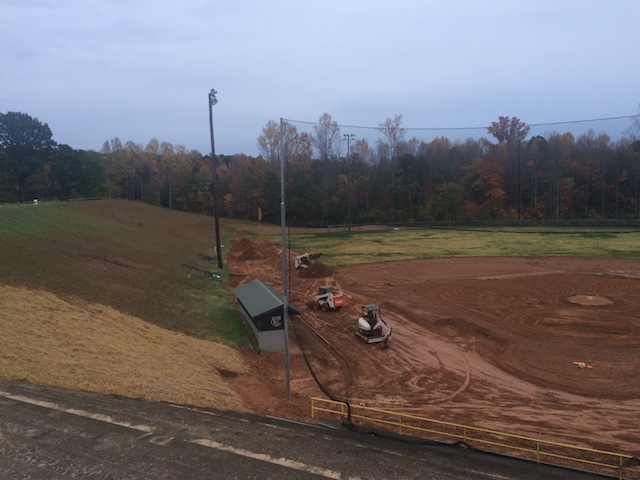By Tom Rychlik
Your role has progressed from field operations technician, through a supervisory role, and finally promoted to a superintendent—congratulations! Now the new director, recently promoted from the recreation side, is requesting that you get his rec folks two new fields. Commonly, the components to a successful design, construction, and grow-in project, are not the curriculum of the years training in park and school districts.
As a civil engineer who works commonly with park and school districts on developing their new fields, I empathize with the role that you have now been cast. What follows, we hope, is a brief primer on some of the questions that you will want to answer, or at least, formulate opinions on, to best leverage your district’s resources.
What are you looking to do?
This might sound a bit nebulous, however understanding the end goal, defining what the objective outcome as early as possible, is critical. All of these projects draw on the communication between demand (recreation supervisor or athletic director) and supply, or operations staff (parks department or facilities staff). Ultimately, your district will engage an appropriate consultant and having a handle on these questions will make efficient application of their time.
Expand
For example, you are told, “We have four soccer fields now, knock that neighbor’s house down and build me a quad of baseball diamonds.” How should the district proceed with land acquisition? Condemnation, eminent domain, or call the local realtor? What entitlement process is in ordinance for the expansion of your district’s land? If you have the land, or after you’ve acquired it, what conditions exist for the project to handle. Good sandy subsoils? Or murky, organic silty clay? Potentially, expanding the site may also require traffic engineering considerations, like additional parking, access, or offsite improvements, as the municipality dictates. Vacating right of way may also require relocation of public utilities. Expansions may require stormwater management, depending again on your region, and the local ordinances.
Consolidation
For example, we have a pair of large baseball fields for high school scale baseball, but the demand has steadily declined, and we see a growth in demand for adult softball leagues. How much demand? Enough to warrant skipping the skinned infield in favor of a synthetic turf system? Typically these will require the irrigation and/or lighting system to be manipulated or full out replaced. What condition are the backstops or other baseball equipment; should any of these be salvaged?
Increased use
For example, we have enough soccer fields, but would love to start up a second league using the same turf. As compaction increases from the continued use, does the district have the capacity to combat with mechanical means? Should the district consider shifting from natural to synthetic surface to provide the fields in response to the growing program demand?
Increased level of service
For example, converting a practice field for use in tournament soccer games, or a turfgrass grid to a Friday night football field. To those not in the maintenance field, few will understand the increase in demand when a practice field that sees four or five weekly practices in various areas of the field moves to a consistently striped football field, where the turf between the hashes is constantly fighting compaction.
Increasing the level of service also may warrant adding in irrigation, athletic light towers, perimeter fencing, and bleachers. Knowing the parameters of the demand will facilitate the scope of the design and construction.
Within the facilities or parks department, a critical parameter to be aware of is your limit of maintenance. The expansions in field, the new stadium are great, however without the manpower, equipment, or material resources, these will be hardscrabble in months without being maintained appropriately. Would your district authorize out-sourcing aeration or other additional activities that could assist in maintaining the high-end fields you provide. Should the project include new synthetic surface, did the project’s budget provide grooming and cleaning equipment for keeping the new playing area in top shape (and within the parameters of the product’s warranty!)
If there is not a system in place to gather answers to your questions, commonly a land planner or landscape architect are skilled in outlining the stakeholders, effectively soliciting the demands from each, and organizing the data to facilitate the decision process. Once this information is collected, and you are ready to engage your design team, the last task is to ascertain which types are necessary/appropriate, again to best fit the demands of your district.
Typically land planners and landscape architects are skilled in managing the space utilization, envisioning the aesthetics, and commonly well versed in planting applications. When the fields include drainage, utility challenges, subsoil deficiencies, or labyrinthian regulatory ordinances, a civil engineer typically becomes necessary. If the project encompasses building spaces, an architect is needed to efficiently apply space to match demand. For the delivery method, when the trades can be counted on one hand, typically a general contractor and your lead architect/engineer can manage the construction. Once buildings and site work are combined, a construction manager is effective at combining the two trades for effective timing and budget conscious delivery.
Tom Rychlik is an associate/senior civil engineer at Gewalt Hamilton Associates, with licenses in Illinois, Ohio, and Iowa and 18 years of experience, and is a Sports Turf Managers Association member.


